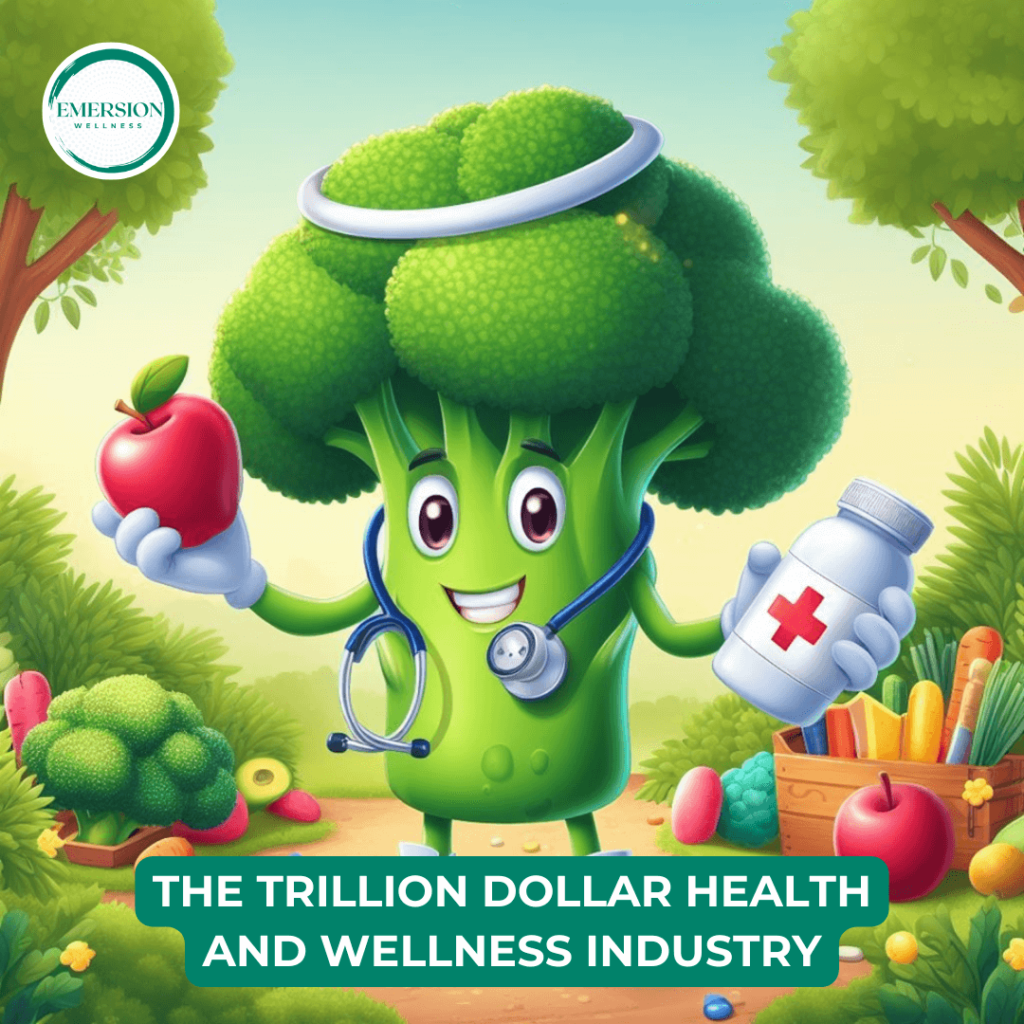Wellness is no longer just a niche but a dominant global force, with health and well-being becoming urgent priorities for consumers worldwide.
This monumental industry now generates over $4.5 trillion annually across sectors like nutrition, fitness, travel, spas, and more. For hoteliers, deeply understanding this flourishing marketplace is vital to capitalizing on wellness's immense opportunities.
Let's examine revealing statistics that quantify the booming health and wellness industry's size, growth, and potential.
Table of Contents
The Massive Scale of Health and Wellness Industry
- The total global wellness economy reached $4.9 trillion in 2020. This represents 5.1% of global economic output.
- Wellness expenditures grew at a 6.2% annual rate from 2017-2020, nearly twice as fast as global GDP.
- 11 distinct wellness sectors combine to form this trillion-dollar market.
The sheer magnitude proves wellness is a lucrative behemoth transforming consumer habits and commerce worldwide.
Diving Into the Components
- Wellness real estate leads at $275 billion, from homes to health-focused communities.
- The spa industry is $119 billion globally across over 150,000 facilities.
- $828 billion is spent annually on healthy eating, nutrition and weight loss.
- Personal care and beauty is a $955 billion market, spanning cosmetics, anti-aging, and more.
- Fitness and mind-body wellness like yoga generate $595 billion.
- Workplace wellness rakes in $57 billion as employers prioritize worker health.
- The $639 billion wellness tourism sector is expanding rapidly.
- Traditional and complementary medicine revenue has hit $413 billion.
- $134 billion flows into preventative health like vitamins, screening, and diagnostics.
- $118 billion is devoted to wellness living - eco-friendly homes and communities.
- $41 billion funds thermal spas and mineral springs for relaxation and healing.
This breakdown spotlights the diverse components comprising the multi-trillion-dollar wellness marketplace.
Regional Wellness Market Leaders
- North America leads with a 38% global share, generating $2 trillion in annual revenues.
- But the Asia-Pacific region is seeing breakneck expansion, now representing 34% at $1.6 trillion.
- Europe claims 21% of the global pie at just over $1 trillion yearly.
- Latin America and the Middle East/North Africa comprise 7%, respectively.
This highlights prime regions for hospitality to target, with massive existing markets and fast-growing emerging ones.
Key Health and Wellness Industry Consumer Demographics
- An estimated 89% of affluent consumers actively pursue wellness.
- Gen Xers and Baby Boomers spend the most on wellness due to more significant disposable income.
- But Gen Z and Millennials demonstrate the highest engagement in wellness lifestyles.
- Women significantly outspend men across most wellness categories.
Understanding these nuances helps hotels fine-tune offerings and marketing to align with target guests.
The Outsized Influence of the Wealthy
- Households earning over $200K spend nearly 3x the average on wellness.
- The wealthiest consumers account for about 33% of total wellness spending.
- Affluent consumers are better informed and more proactively health conscious. Affluent travelers represent the sweet spot for hospitality wellness monetization given their willingness to pay premiums.

Workplace Wellness Uptake
- 70% of US employers now offer a workplace wellness program.
- Participation rose from 20% of workers in 2008 to 60%.
- Employers get $3-$9 back in reduced healthcare costs for every $1 invested.
- 55% of workers say wellness benefits are significant when job hunting.
Catering to corporate wellness travel is a major opportunity hotels cannot ignore.
The Health and Wellness Industry Tourism Surge
- Wellness tourism expanded from $563 billion in 2015 to $639 billion in 2017.
- 691 million wellness trips were taken globally in 2017, up 56% from 488 million in 2015.
- Top motivators are healthy eating/weight loss, fitness, and stress reduction.
- Domestic wellness tourism exceeds international demand in many countries.
With growth wildly outpacing regular tourism, wellness-focused hotels will only widen their advantage.
The Future Health and Wellness Industry Consumer
- Gen Z travelers under 30 already account for 14% of wellness trips.
- Millennial parents list children's health and wellness among top priorities.
- Minorities are the most motivated wellness consumers in the US.
- Mainstream wellness adoption continues rising across income levels.
Conclusion
Tomorrow's travelers will raise expectations further, keeping demand vibrant for hotels.
The meteoric ascent of the health and wellness industry is still in its early chapters. Hospitality is at the epicenter of this movement, primed to shape experiences facilitating consumer wellbeing. With these key statistics as your guide, let's discuss how to unlock wellness's immense potential specifically for your property and business goals. This trillion-dollar megatrend will define the future of our industry. Will you lead the way?
FAQs
-
What wellness sectors are predicted to grow fastest through 2025?
The Global Wellness Institute projects wellness real estate, workplace wellness, wellness tourism, spas, and thermal/mineral springs will expand at an annual average of over 10% through 2025, making them smart targets for hospitality.
-
Which consumer segments represent significant untapped opportunities?
Men, Gen Zers and minorities are all underrepresented currently in the wellness consumer base. Hotels crafting offerings and messaging specifically for these groups stand to benefit enormously from their high motivation and upside.
-
How are hotels expanding their wellness revenue streams beyond rooms?
Top ancillary streams include wellness packages/retreats, spas, pay-to-attend fitness/meditation classes, wellness-focused F&B, retail selling branded products, partnering with outside providers, and subscriptions for locals.
-
What's the breakdown between domestic and international wellness tourism?
In 2017, domestic trips accounted for 72% of wellness tourism's total 691 million visits and 56% of expenditures. But international tourism spends 2.5x more per trip, highlighting the lucrative potential of far-flung travelers.
-
Which wellness modalities are consumers most interested in?
According to the Global Wellness Summit, top rising modalities include HIIT/CrossFit, plant-based eating, meditation, osteopathy, breathwork, infrared saunas, cryotherapy, and cannabis/psychedelic wellness.
-
How has workplace wellness participation grown?
Workplace wellness program engagement leapt from just 20% of employees participating in 2008 to 60% currently. And employers now see $3-$9 in healthcare cost reductions for every $1 invested in wellness.
-
What new wellness programs are employers offering?
Leading options include telehealth services, wearable devices, ergonomics consulting, mental health apps, nutrition counseling, fitness studios/gyms subsidies, onsite health clinics, resilience/mindfulness training and health insurance incentives.
-
How does wellness benefit business travel hotel stays?
Offering amenities like healthy menus, fitness facilities, outdoor spaces, and spa services helps attract business travelers. Promoting these can also enable hotels to charge premium rates.
-
What's driving wellness real estate growth?
Developers cite strong demand from homebuyers of all ages seeking communities supporting holistic health. The pandemic also made access to wellness amenities more urgent for home-bound consumers.
-
Where are the best regions internationally for wellness retreats?
According to the Global Wellness Tourism Economy report, top wellness retreat destinations span Bali, India, Thailand, China, Mexico, Costa Rica, Spain, Switzerland, Peru, and Turkey based on current development and consumer interest.
Here are the sources for the statistics cited in the article:
- Global wellness economy reached $4.9 trillion in 2020: Global Wellness Institute, "Global Wellness Economy Monitor", December 2021
- Wellness growing at 6.2% annually from 2017-2020: Global Wellness Institute, "Global Wellness Economy Monitor", December 2021
- $275 billion wellness real estate market: Global Wellness Institute, "Build Well to Live Well", January 2022
- $119 billion global spa industry: Global Wellness Institute, "Global Wellness Economy Monitor", December 2021
- $828 billion spent on nutrition/weight loss: Global Wellness Institute, "Global Wellness Economy Monitor", October 2018
- $955 billion personal care/beauty market: Global Wellness Institute, "Global Wellness Economy Monitor", October 2018
- $595 billion fitness/mind-body market: Global Wellness Institute, "Global Wellness Economy Monitor", October 2018
- $57 billion workplace wellness market: Global Wellness Institute, "Global Wellness Economy Monitor", December 2021
- $639 billion wellness tourism market: Global Wellness Institute, "Global Wellness Tourism Economy", November 2018
- $413 billion traditional/complementary medicine market: Global Wellness Institute, "Global Wellness Economy Monitor", October 2018
- $134 billion preventative health market: Global Wellness Institute, "Global Wellness Economy Monitor", October 2018
- $118 billion wellness lifestyle real estate market: Global Wellness Institute, "Build Well to Live Well", January 2022
- $41 billion thermal/mineral springs market: Global Wellness Institute, "Global Wellness Economy Monitor", October 2018
- 89% of affluent consumers pursue wellness: Natural Marketing Institute, "Reaching the Multi-Dimensional Wellness Consumer", 2017
- Gen X/Boomers spend most on wellness: Finder.com, "Wellness Statistics", August 2021
- Gen Z/Millennials have highest wellness engagement: Global Wellness Institute, "The Future of Wellness", 2016
- Women significantly outspend men on wellness: Finder.com, "Wellness Statistics", August 2021
- $200K+ households spend 3x average on wellness: Natural Marketing Institute, "Reaching the Multi-Dimensional Wellness Consumer", 2017
- Wealthiest consumers account for 33% of spending: Natural Marketing Institute, "Reaching the Multi-Dimensional Wellness Consumer", 2017
- 70% of employers offer wellness programs: RAND Corporation, "Workplace Wellness Programs Characteristics and Requirements", 2016
- Participation rose from 20% to 60%: RAND Corporation, "Workplace Wellness Programs Characteristics and Requirements", 2016
- $3-$9 healthcare cost reduction per $1 spent: Harvard Business Review, "Employee Wellness Programs Aren't Working", November 2018
- 55% say benefits very important job hunting: Employee Benefits News, "More Employees Motivated by Wellness Benefits", June 2021
- Wellness tourism grew from $563B in 2015 to $639B in 2017: Global Wellness Institute, "Global Wellness Tourism Economy", November 2018
- 691 million wellness trips in 2017, up 56%: Global Wellness Institute, "Global Wellness Tourism Economy", November 2018
- Gen Z 14% of wellness travel: Global Wellness Institute, "The Future of Wellness Tourism", May 2021
Get In touch for more Details
Also Read: What are the Common Hotel Funding Sources?

I'm Nathan Baws, a nutrition nerd, exercise and weight loss expert, and an unwavering advocate for good health. As the founder of Emersion Wellness, I'm passionate about crafting Seamless Weight Loss Programs to supercharge hotel revenue and transform lives. We've pioneered the World's First Plug & Play Weight Loss Programs for top hotels and resorts, sparking a wellness revolution. Beyond my professional journey, you'll often find me hiking, swimming, and riding the waves, embracing every moment in nature. Join me on this exhilarating journey towards diet, health and wellness.

